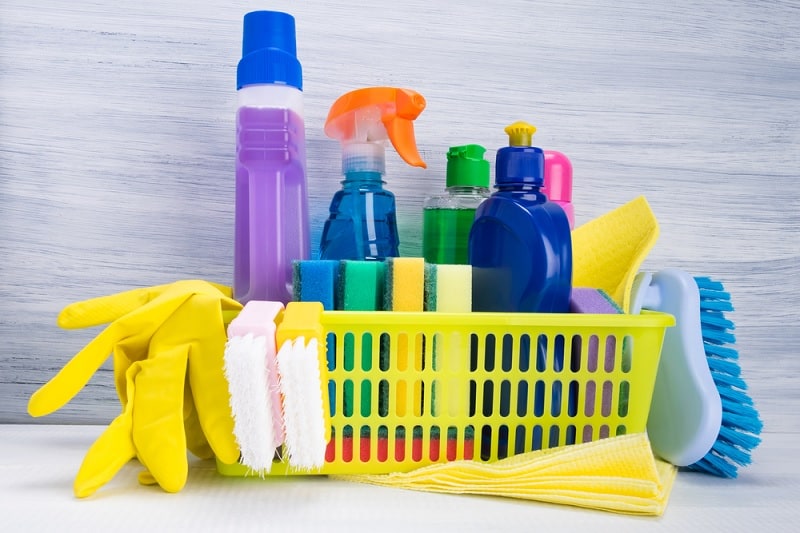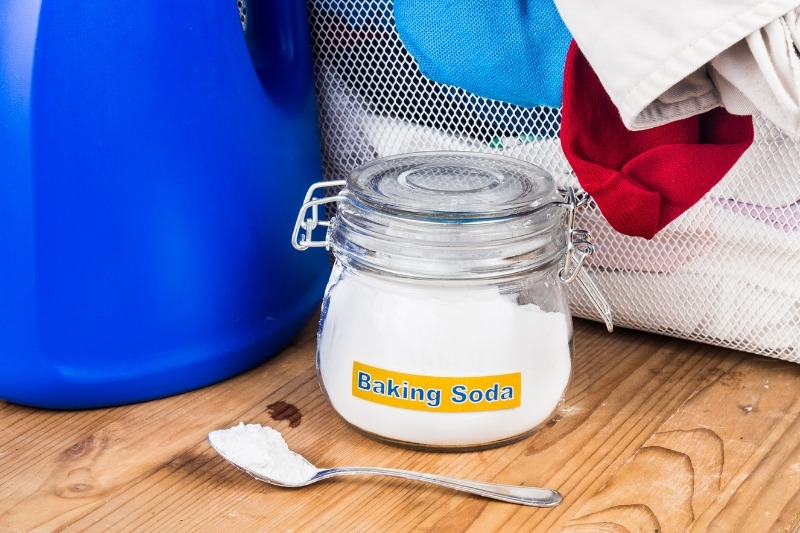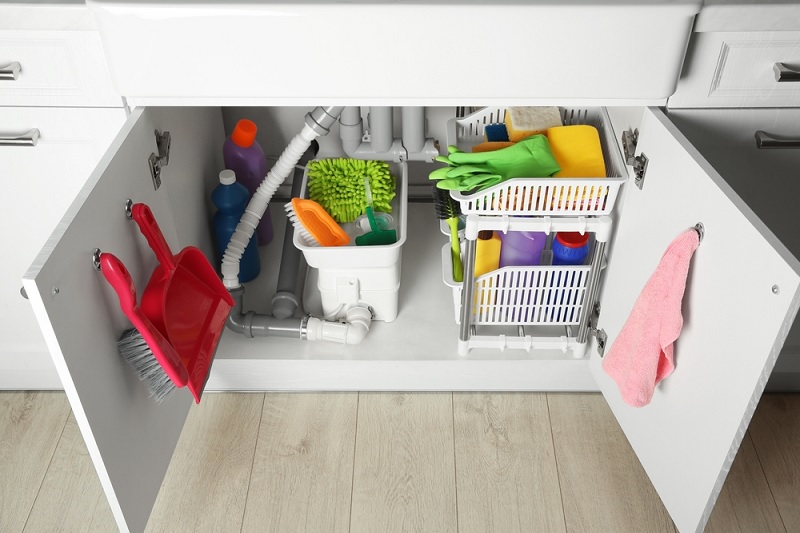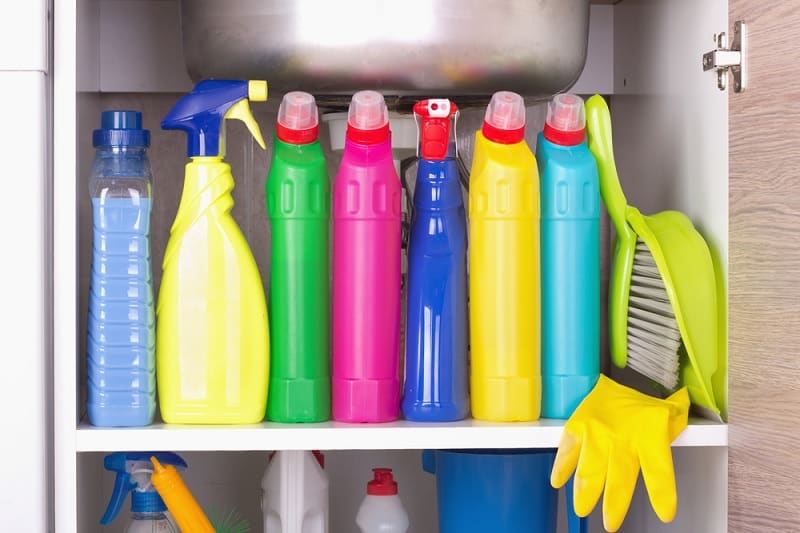Every home will have at least some basic household cleaning products.
Even if you don’t consider yourself an avid cleaner, you’ll likely have some spray cleaners, a duster, a vacuum cleaner and some bleach.
Of course, some of us will have far more extensive cleaning product collections.
But have you ever thought about how (and where) to store your cleaning products? If not, this is the article for you.
Below, we’ll discuss how to store cleaning products along with some location and organisation tips.
How to Store Cleaning Products
The absolute basic necessity for storing cleaning products is a cool, dry place.
Some products will react negatively to humidity, whereas others can be affected by temperature fluctuations. Ideally, there should be some ventilation, too, just to prevent the build-up of fumes.
Of course, finding this sort of location is easier said than done. Luckily, we can take the dry part with a pinch of salt. As such, some ideal places to store cleaning products include:
- Under the kitchen sink
- In a bathroom cabinet
- In an organiser on the back of a door
- In a garage or laundry room
Generally, cleaning products in airtight plastic containers should be fine kept in a kitchen or bathroom.
You’ll want to look for another storage place for products in cardboard boxes, especially powders.
Then there are actual cleaning tools, such as vacuum cleaners, mops, dusters, etc. These take up far more room than bottles of cleaning products.
However, you won’t be as restricted because they shouldn’t be affected by temperature and moisture. An airing cupboard or spare space behind a door should be fine for most of them.
Where’s the safest place to store cleaning products?
The safest place to store cleaning products is an outdoor building, such as a garage.
Ideally, you should be able to lock the door and/or the cabinet you’re storing them in. This’ll prevent kids and pets from getting to the cleaning products, which is especially important for dangerous things like bleach.
It should be fine to store safer products, such as vinegar, under a kitchen sink. But if you don’t have an outdoor building, make sure your cleaning products are kept in a cupboard off the ground, so it’s harder for kids and pets to reach them.
On top of this, you might want to consider putting locks on the cupboard doors. Something like these Booboo Child Safety Door Straps should be fine for pets and toddlers. Hopefully, by the time your kids are old enough to open them, they should be past the stage of putting random things in their mouths!
Tips for Storing Cleaning Products
So, once you’ve found somewhere to store your cleaning products that’s safe and accessible, you’ll need to think about organising them.
Just chucking them in a cupboard might be fine if you’ve only got one or two things, but larger cleaning arsenals will benefit from some organisation.
To help you out, here are our top tips for how to store cleaning products properly.
1. Check what can be stored together
First, think about what can and can’t be stored together. You’ll generally want to keep powders and liquids separate in case there’s a leak.
On top of that, there are certain products you absolutely don’t want to keep together in case they mix. These are:
- Bleach and vinegar – make chlorine gas
- Bleach and ammonia – make chloramine
- Hydrogen peroxide and vinegar – make peracetic acid
- Bleach and ammonia – make phosgene gas
Provided you store bottles upright and properly replace their lids, this shouldn’t be an issue. But considering it’s not difficult to keep these products separate, it’s better to be safe than sorry.
2. Make use of baskets

Get yourself some storage baskets for better organisation. They don’t need to be fancy – something like these Whitefurze Storage Baskets will work fine.
Make sure they fit next to each other in your chosen storage area for efficient storage.
Then, label the baskets for different cleaning jobs or rooms. For example, you could have a “kitchen” basket that has cooker spray, anti-bac spray, etc. You could also have a “dusting” basket that’s simply dusters and furniture polish.
There are some minor exceptions to this rule, though. It makes sense to keep regularly-used or specific products near where you need them.
This might be washing up liquid and dishwasher tablets in the kitchen or shower spray in the bathroom. If it’s something you use daily, keep it near where you need it.
3. Set up a cleaning caddy
Along with your baskets for storing bulk or occasional items, set up a caddy or two for products that are used together on a weekly basis.
For example, you could have a bathroom caddy that has everything you need, such as sprays, cloths, sponges, etc. These should be easy to slot into your storage cupboard next to your baskets.
4. Try a lazy Susan
A lazy Susan is one of those turntables you sometimes find on restaurant tables to help move food around.
If you have a deep cupboard and lots of cleaning bottles, it can be an ideal substitute for baskets.
Set one up in a large, deep cupboard and it’ll be much easier to access all your cleaning supplies. Used in place of baskets, it means you won’t lose anything at the back of the cupboard.
5. Mount mops and dusters
Another efficient use of space is to mount larger items on the back of doors. Of course, this won’t work for a vacuum cleaner but will be ideal for mops, brooms and large dusters.
Something like these TDBS Broom Holders will be ideal. They have self-adhesive backing and hold all kinds of household cleaning tools.
Mounting these on the back of a door can make it much easier to store those awkward long-handled cleaning tools.
6. Decant powders into airtight containers

If you don’t have an option for a low-humidity storage place, the next best thing for powders is to decant them into airtight containers.
Things like borax and bicarbonate of soda will go clumpy if they get moist, and this can ruin them if left for too long.
You can obviously use any airtight containers you can find. Plastic will be fine, but glass containers won’t take on odours.
Just make sure you label the boxes to avoid getting them mixed up! This can be as simple as cutting the product name out of its box and sticking it to the lid.
7. Use an over-door shoe organiser
This tip won’t be suitable for people with kids or pets. But if you’re really short of space in cupboards, an over-door shoe organiser is ideal for storing bottles of cleaning products. This Misslo Shoe Organiser would work well over the back of a kitchen door.
It should be fairly easy to see what product is where using this kind of storage, but it might help to stick labels onto each pouch so you always know where to look for a cleaning product.

Final Thoughts
And there you have it: the best options for how to store cleaning products. At the most basic level, ensuring you have somewhere cool and dry should be enough. But if you have a lot of products to store, get your organisation brain in gear.
When sorting your cleaning products, though, keep like-for-like together and always make sure potentially harmful products are kept well away from kids and pets. And if that’s not possible, make sure you lock the products away!


Jacob is a writer based in Wales, where he lives with his partner and two dogs. All his work is fuelled by extensive research and buckets of coffee.






